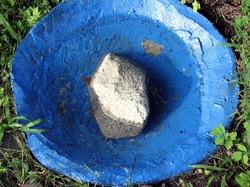
The answer to this question depends on how we define swimming. Ants do not use a "breaststroke" to navigate water, but they do have the ability to effectively cross water to find possible food sources. I believe that the secret to their success is due to the fact that they have sufficient buoyancy to avoid immediate drowning. My observations so far suggest that some ants seem to do the equivalent of a dog paddle or a similar designed leg movement. But the majority seem to just flail their way across a length of water. They are able to float for a long time when they tire from moving, become disorientated easily, and once they find land, or a rock in this case, they are reluctant to return to the water. It is well known that ants use scent trails to mark direction for other ants to follow, but in the water, this is not possible.
A few words about the video. I do not have real macro video capability so although the video has some faults, I did my best to illustrate these amazing insects. For a really great video made in Europe with fantastic images and professional experiments, but no swimming, go to this 54 minute documentary here. By the way, the little guy at the end did make it to the rock after about ten minutes!
 RSS Feed
RSS Feed
